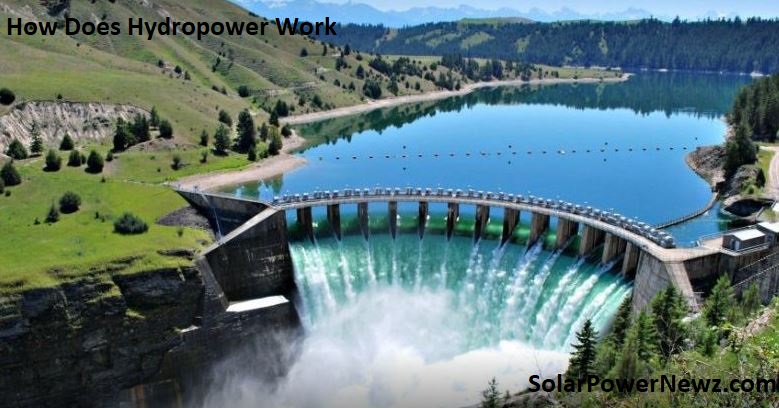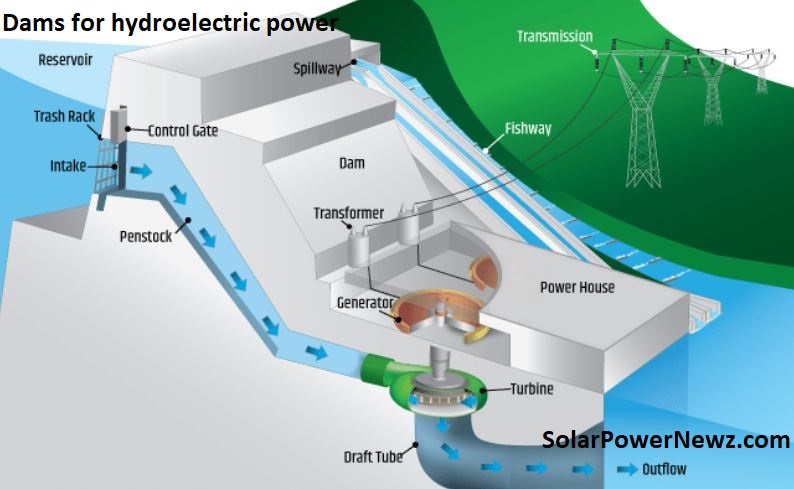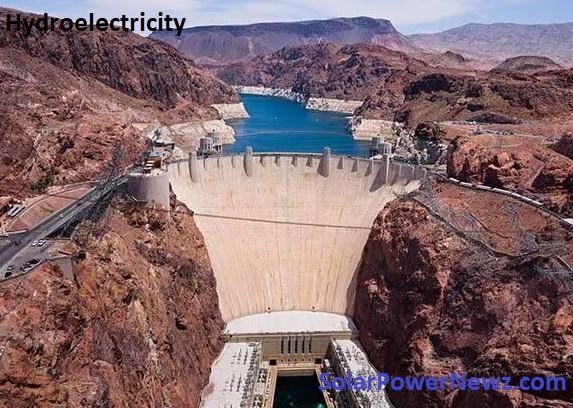In this article we will discuss How Does Hydropower Work, advantages and disadvantages. Hydropower is a phrase used to describe electricity generated by harnessing the kinetic energy of moving water. Hydroelectric dams are a frequent way of generating hydroelectric electricity and are highly reliable when built in the correct setting.
The sections that follow go through what hydropower is and how we can generate it.

Table of Contents
How Does Hydropower Work
Utilizing the power of moving water to produce electricity is known as hydropower. It is a renewable energy that may be obtained from a variety of places, such as rivers, oceans, and artificial reservoirs.
The fundamental idea behind hydropower is straightforward: as water moves, it creates kinetic energy that may be used to produce electricity. A turbine is positioned in the water’s course to capture this energy. The water’s kinetic energy is transformed into mechanical energy by the turbine’s blades as it rushes past them. Once a generator is turned by the mechanical energy, the mechanical energy is transformed into electrical energy.
The amount of water flowing through the turbine, the vertical drop or “head” of the water, and the turbine’s design are some of the variables that affect a hydropower system’s efficiency.
Two primary varieties of hydroelectric power plants exist:
- Impoundment facilities: a reservoir is used to store water behind a dam, and a turbine is used to release it.
- Run-of-river facilities: These facilities don’t store water; instead, they use a river’s natural flow to generate energy.
The following are the most prevalent types of hydropower turbines:
- Pelton turbines
- Francis turbines
- Kaplan turbines
In general, hydroelectric power has low operating costs and emissions and is very dependable. However, substantial harm can be done to fish, riverine, and migratory creatures as well as to nearby communities that depend on the regular flow of the rivers by major hydroelectric installations.
How Is Hydropower Produced
Water that is moving or flowing contains kinetic energy that can be used to generate electricity. We can create hydropower in a variety of methods. The most popular method is to use a hydroelectric dam, which we will discuss further below.
Dams for hydroelectric power
A hydroelectric dam generates electricity by enclosing a big body of water. This generates a man-made reservoir that the dam may use to power turbines incorporated into its framework. To increase power output, large hydroelectric power facilities frequently employ multiple turbines. This dam has eight turbines in all, as shown in the image below.

The flow of water from the reservoir is controlled by hydro plant operators. These water flows will follow a predetermined path via the dam framework. They will finally collide with the turbines. When they do, the turbines begin to spin and generate electricity. The amount of electricity produced by turbines is determined by their size and capacity.
Using Other Means
We don’t necessarily need to construct massive hydroelectric dams to generate hydropower. Some businesses have even recognised the potential of the kinetic energy of our rivers’ flowing water. Such businesses have been able to construct small-scale hydroelectric projects, a technology known as “micro hydro.” This technology enables power companies or even small businesses (as well as some homeowners) to create lesser amounts of hydroelectricity.
Micro hydro systems have a significantly lower influence on the environment. We may utilise them to harness the force of flowing water without damming a river. We can accomplish this by employing machines comparable to water wheels, which have traditionally been used to power mills and factories. Such water wheels can turn only on the natural flow of a river. This can create small amounts of electricity, enough to power a small building.
What Is the Cost of Hydropower
A more cheap source of electricity than most is hydropower. States like Idaho, Washington, and Oregon, which rely mostly on hydropower for their electricity production, have cheaper energy costs than the rest of the nation since hydropower solely uses the energy from moving water.
Hydropower also offers comparatively cheap expenses over the course of a whole project lifetime in terms of upkeep, operations, and fuel compared to other electricity sources. Like any major energy source, hydropower has considerable upfront expenses that cannot be avoided, but because of its extended lifespan, these costs are dispersed over time. Additionally, the machinery employed at hydropower facilities frequently lasts longer before needing to be replaced or repaired, saving money over time.
Large hydropower facility installation costs are mostly made up of costs for civil construction (such as building the dams, tunnels, and other related infrastructure) and electromechanical equipment (electricity-generating machinery). Hydropower is a site-specific technology, thus by carefully choosing the location and design at the planning stage, these expenses can be reduced.
Is hydroelectricity costly?
Hydroelectricity is only costly because of the initial expense of constructing a hydroelectric dam. This is a complex technical procedure that might take several years of planning and building before a dam is completed.
The only ongoing costs after the dam’s construction are for its operation and maintenance. A hydroelectric dam, unlike non-renewable power plants, does not require the purchase of fuel to drive the turbines and create energy.
What are the benefit of Hydropower
Hydropower has been used for thousands of years because of its advantages, which have been recognised. Hydropower plants can instantly supply electricity to the grid, making them a flexible and dependable source of backup power during significant electrical outages or disturbances. Hydropower plants are also a clean and affordable source of energy. Flood control, agricultural support, and water supply are just a few of the advantages that hydropower also brings about outside of the production of energy.
The Reliability of Hydropower
Hydropower is an extremely dependable and efficient renewable energy source. Unlike some other renewable energy methods, the construction of a hydroelectric dam can provide a steady electrical supply. Solar panels, for example, are subject to darkness, whereas wind turbines are vulnerable to wind levels. Hydroelectricity, on the other hand, may be practically constant when produced under the correct conditions.

Aside from consistent electricity production, hydropower has the added advantage of being able to respond swiftly to fluctuating electrical demands. The water intake can be raised to allow turbines to spin faster or to bring additional turbines online almost instantly. This is useful during peak electricity demand periods. Traditional power plants (such as those powered by coal or oil) require substantially more time to react to increases in electrical demand.
Hydropower advantages and disadvantages
By capturing the energy of moving water, hydropower is a type of renewable energy that produces electricity. It has several advantages and disadvantages.
Advantages
- Energy source that is renewable: Hydropower is a clean, sustainable energy source because it doesn’t emit any greenhouse gases or other pollutants.
- Effectiveness in terms of cost: After the initial building costs are covered, hydropower is comparatively cheap to produce.
- Due to its independence from weather and fossil fuels, hydropower is a dependable source of electricity.
- Hydropower is versatile and can be utilised for a number of tasks, such as the production of energy, irrigation, and flood control.
- Low maintenance: Once in operation, hydropower plants only need occasional maintenance.
Disadvantages
- High upfront expenditures: Building a hydroelectric plant can be expensive, and it may take years for those expenses to be recovered.
- Impact on the environment: The development of hydropower plants may have detrimental effects on the environment, such as the eviction of wildlife and the modification of river ecosystems.
- Limited availability: Hydropower can only be produced in locations with a sufficient water supply and an appropriate topography, which restricts its application in some areas.
- Flooding: Serious flooding from a large hydropower dam can harm the land, villages, and force the displacement of residents.
- Weather dependent: The production of electricity from hydropower may be affected by restricted water supply during times of drought.
History of Hydropower
Hydropower has a long, illustrious history. For instance, almost 2,000 years ago, the Greeks ground wheat into flour using water wheels. In the middle of the eighteenth century, Bernard Forest de Bélidor, a French hydraulic and military engineer, published Architecture Hydraulique, which marked the beginning of the development of the modern hydropower turbine. The first half of the 19th century saw a number of significant advances in hydropower technology, and more recently, the last century has seen a number of hydroelectric innovations that have helped hydropower become an essential component of the renewable energy mix in the United States.
Overview
In many parts of the world, hydropower is critical to ensuring a long-term and consistent source of electricity. We have the ability to create enormous amounts of electricity at a low cost and with little to no pollution. This is fantastic news for the environment and the air we breathe.